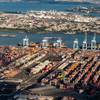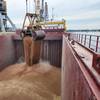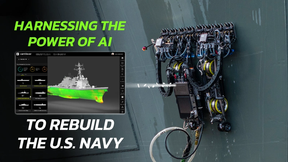Tonnage Numbers Steady at U.S. Ports
U.S. ports continued to post positive tonnage numbers in October. The Seaway’s year-to-date total cargo shipments from March 22 to October 31 were 29 million metric tons, up 2 percent from the same period last year.
“With just two months left in the 2011 navigation season, the Seaway is on track to meet its projected seven percent improvement over last year’s tonnage performance,” says Rebecca Spruill, Director of Trade Development for the Saint Lawrence Seaway Development Corporation. “General cargoes like steel slabs and coils and wind turbine components are posting solid increases, while we’re moving nearly a million tons more of petroleum products than last season.”
In early October, 18,000 metric tons of hot-rolled steel coils produced at ArcelorMittal’s Burns Harbor facility in Indiana were delivered to the Republic of Macedonia. “Northwest Indiana is the richest steel-producing region in the world and being able to access world markets through our port is vital for ArcelorMittal and many other companies,” said Peter Laman, port director of the Port of Indiana-Burns Harbor.
He added, “This is the first substantial steel export from the port since 2008. Year-to-date steel shipments through the port are up more than 20 percent over last year, with 2011 on target for having the highest steel shipments since 2007. Whether it’s bringing in raw materials or shipping out finished products, steel companies can substantially reduce their logistics costs by shipping through our port.”
The Toledo Port Authority was another Great Lakes port registering tonnage increases. “Through the month of October, seaport cargo tonnage remained nearly 4 percent ahead of the same period in 2010 with increases in all major cargo categories (petroleum products, general cargo, and iron ore), with the exception of coal and grain. Through October, the port handled 9.2 million short tons and 13 more vessels than at the same point in 2010. The month finished strong as grain began to pick up due to the fall harvest,” explained Joseph Cappel, director of cargo development at the Port.
Diversification has been a critical component to growing port commerce during difficult economic times. “The Port of Green Bay has historically been a leading indicator of regional fiscal conditions in Wisconsin,” said Dean R. Haen, port manager. “The fact that the port has seen a 26 percent increase in tonnage from 2010 to 2011 is a positive sign for the port and our regional economy.” One port tenant, US Venture, continues to be the main driver in increased tonnage and ship arrivals in 2011. They teamed with Wisconsin’s Department of Transportation and invested in opening an inactive port terminal last year which, amidst tough economic conditions, is now paying dividends. October tonnage increases for coal for power generation were up 15 percent year-to-date, while the construction industry demand for cement rose 11 percent from the same time last year. The 69 percent year-to-date increase in gypsum handled by the port was for industrial use.
St. Lawrence Seaway shipments of petroleum products and salt continued up at 90 percent and 33 percent respectively compared to October 2010. Coal shipments totaled 62,000 metric tons in October, a two percent increase from the same month last year. Year-to-date scrap metal and coke shipments saw double digit increases for October 2011. Other general cargo like wind turbine components, increased 31 percent over last year.
The Great Lakes-St. Lawrence Seaway maritime industry supports 227,000 jobs in the U.S. and Canada, and annually generates $14.1 billion in salary and wages, $33.5 billion in business revenue, and $4.6 billion in federal, state/provincial and local taxes. North American farmers, steel producers, construction firms, food manufacturers, and power generators depend on the 164 million metric tons of essential raw materials and finished products that are moved annually on the system. This vital trade corridor saves companies $3.6 billion per year in transportation costs compared to the next least-costly land-based alternative.














